Contemporary Travel and Tourism Industry: An In-depth Analysis Report
VerifiedAdded on 2020/11/12
|18
|6064
|194
Report
AI Summary
This report provides an in-depth analysis of the contemporary travel and tourism industry. It begins with an introduction to the sector, emphasizing its economic significance and evolution. Task 1 delves into the historical milestones of the industry, examining its progression from the 16th century to the present, highlighting the changing purposes of travel, modes of transportation, and the emergence of travel agents. It also discusses the various sectors within the industry, such as accommodation, food and beverages, and transportation, emphasizing their importance in meeting customer requirements and maintaining a competitive edge. Task 2 explores the direct and indirect elements of the industry, such as accommodation, transportation, amenities, and communication, and their interrelation in creating a positive tourist experience. The report also discusses the roles of these elements in detail, emphasizing the importance of amenities, communication, and the interrelation between internal and external factors in creating an ultimate experience for tourists. The report concludes with a summary of the key findings and the significance of these elements in the overall success of the travel and tourism industry. Finally, a list of references is provided.
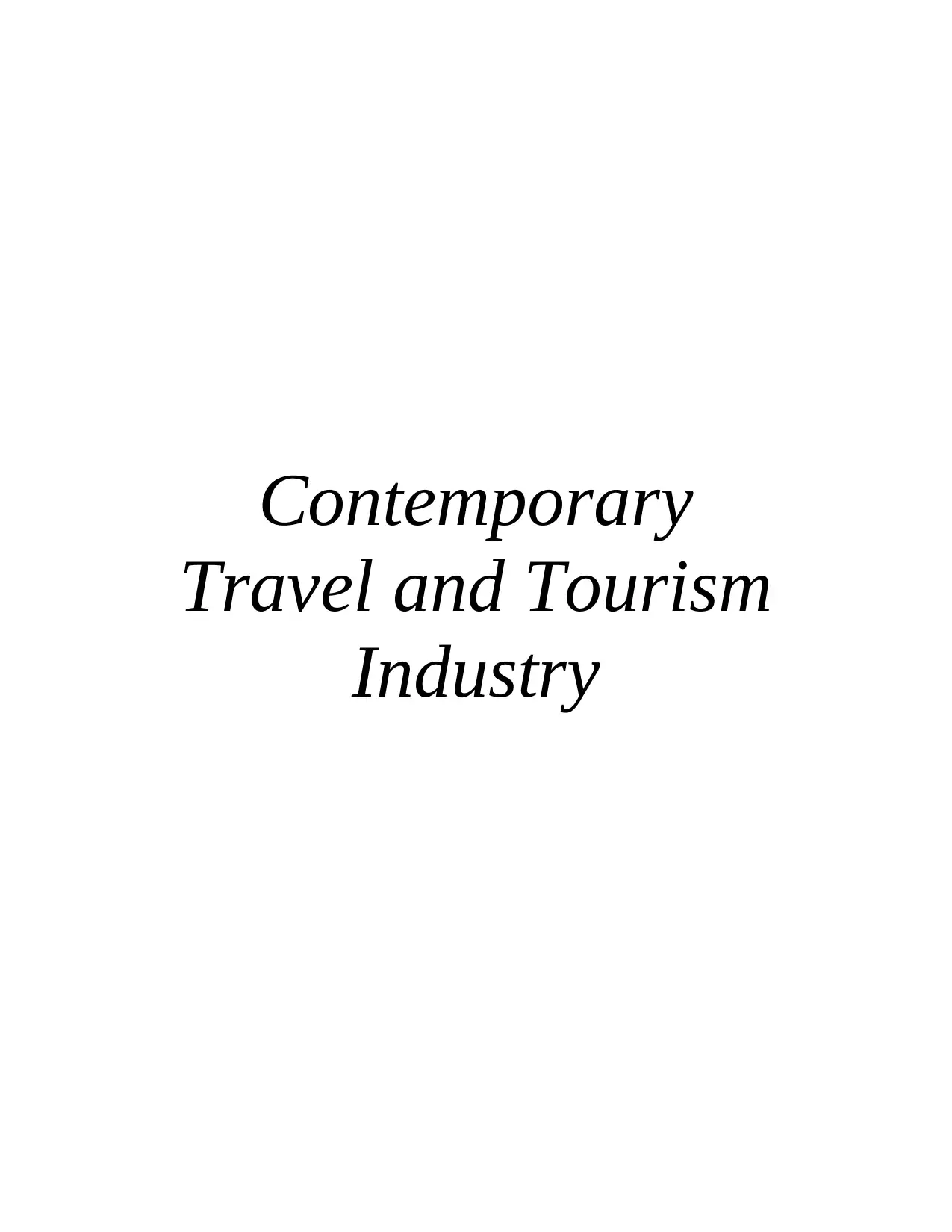
Contemporary
Travel and Tourism
Industry
Travel and Tourism
Industry
Paraphrase This Document
Need a fresh take? Get an instant paraphrase of this document with our AI Paraphraser
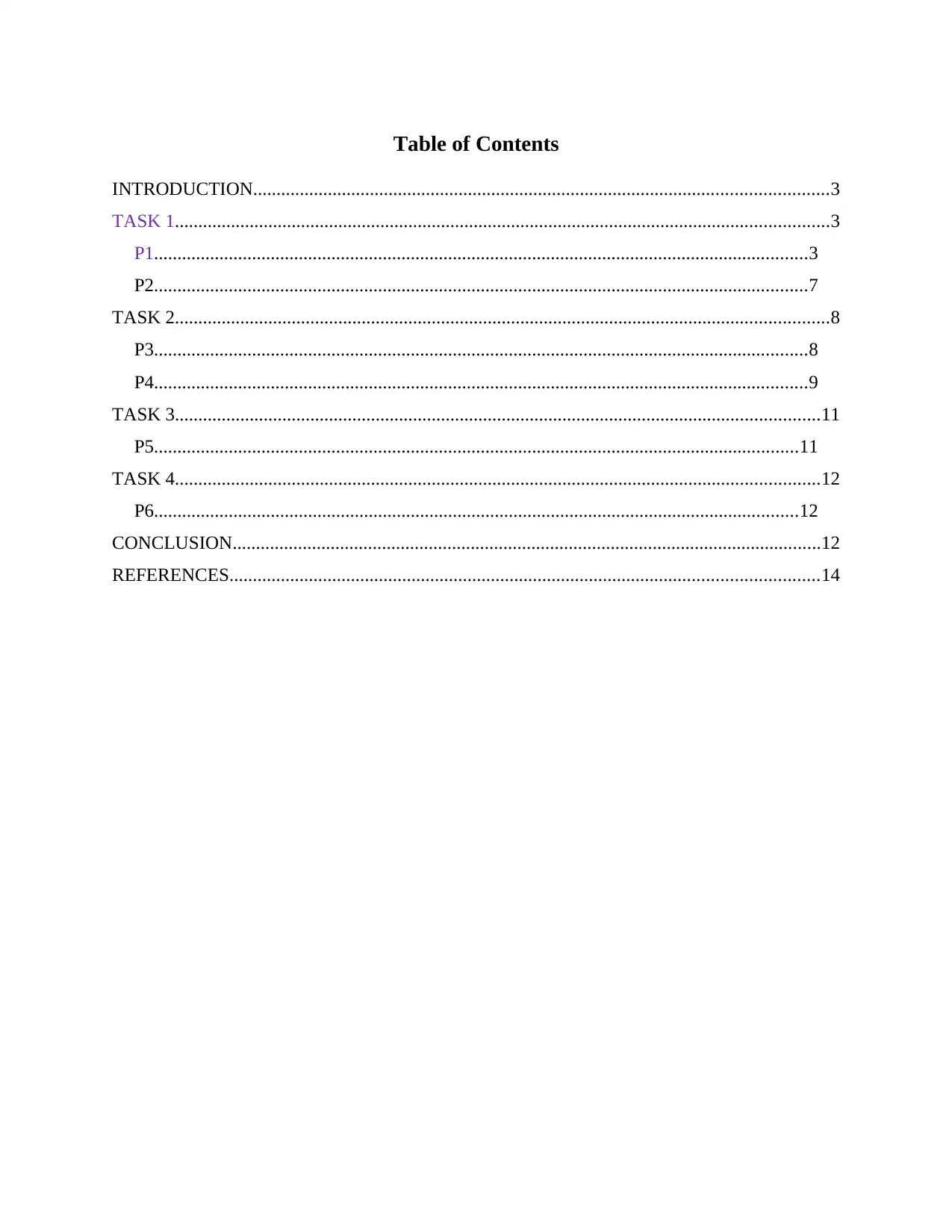
Table of Contents
INTRODUCTION...........................................................................................................................3
TASK 1............................................................................................................................................3
P1............................................................................................................................................3
P2............................................................................................................................................7
TASK 2............................................................................................................................................8
P3............................................................................................................................................8
P4............................................................................................................................................9
TASK 3..........................................................................................................................................11
P5..........................................................................................................................................11
TASK 4..........................................................................................................................................12
P6..........................................................................................................................................12
CONCLUSION..............................................................................................................................12
REFERENCES..............................................................................................................................14
INTRODUCTION...........................................................................................................................3
TASK 1............................................................................................................................................3
P1............................................................................................................................................3
P2............................................................................................................................................7
TASK 2............................................................................................................................................8
P3............................................................................................................................................8
P4............................................................................................................................................9
TASK 3..........................................................................................................................................11
P5..........................................................................................................................................11
TASK 4..........................................................................................................................................12
P6..........................................................................................................................................12
CONCLUSION..............................................................................................................................12
REFERENCES..............................................................................................................................14
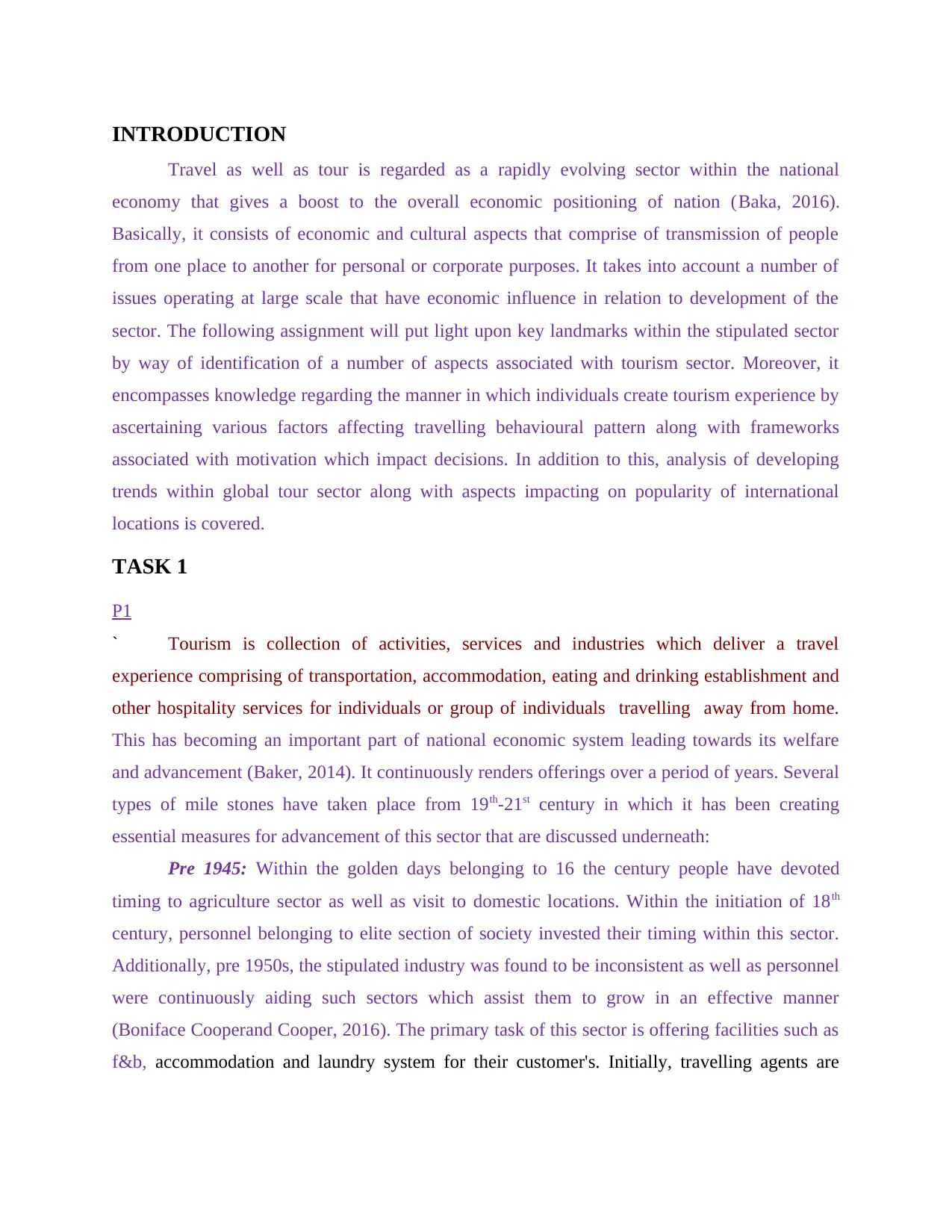
INTRODUCTION
Travel as well as tour is regarded as a rapidly evolving sector within the national
economy that gives a boost to the overall economic positioning of nation (Baka, 2016).
Basically, it consists of economic and cultural aspects that comprise of transmission of people
from one place to another for personal or corporate purposes. It takes into account a number of
issues operating at large scale that have economic influence in relation to development of the
sector. The following assignment will put light upon key landmarks within the stipulated sector
by way of identification of a number of aspects associated with tourism sector. Moreover, it
encompasses knowledge regarding the manner in which individuals create tourism experience by
ascertaining various factors affecting travelling behavioural pattern along with frameworks
associated with motivation which impact decisions. In addition to this, analysis of developing
trends within global tour sector along with aspects impacting on popularity of international
locations is covered.
TASK 1
P1
` Tourism is collection of activities, services and industries which deliver a travel
experience comprising of transportation, accommodation, eating and drinking establishment and
other hospitality services for individuals or group of individuals travelling away from home.
This has becoming an important part of national economic system leading towards its welfare
and advancement (Baker, 2014). It continuously renders offerings over a period of years. Several
types of mile stones have taken place from 19th-21st century in which it has been creating
essential measures for advancement of this sector that are discussed underneath:
Pre 1945: Within the golden days belonging to 16 the century people have devoted
timing to agriculture sector as well as visit to domestic locations. Within the initiation of 18th
century, personnel belonging to elite section of society invested their timing within this sector.
Additionally, pre 1950s, the stipulated industry was found to be inconsistent as well as personnel
were continuously aiding such sectors which assist them to grow in an effective manner
(Boniface Cooperand Cooper, 2016). The primary task of this sector is offering facilities such as
f&b, accommodation and laundry system for their customer's. Initially, travelling agents are
Travel as well as tour is regarded as a rapidly evolving sector within the national
economy that gives a boost to the overall economic positioning of nation (Baka, 2016).
Basically, it consists of economic and cultural aspects that comprise of transmission of people
from one place to another for personal or corporate purposes. It takes into account a number of
issues operating at large scale that have economic influence in relation to development of the
sector. The following assignment will put light upon key landmarks within the stipulated sector
by way of identification of a number of aspects associated with tourism sector. Moreover, it
encompasses knowledge regarding the manner in which individuals create tourism experience by
ascertaining various factors affecting travelling behavioural pattern along with frameworks
associated with motivation which impact decisions. In addition to this, analysis of developing
trends within global tour sector along with aspects impacting on popularity of international
locations is covered.
TASK 1
P1
` Tourism is collection of activities, services and industries which deliver a travel
experience comprising of transportation, accommodation, eating and drinking establishment and
other hospitality services for individuals or group of individuals travelling away from home.
This has becoming an important part of national economic system leading towards its welfare
and advancement (Baker, 2014). It continuously renders offerings over a period of years. Several
types of mile stones have taken place from 19th-21st century in which it has been creating
essential measures for advancement of this sector that are discussed underneath:
Pre 1945: Within the golden days belonging to 16 the century people have devoted
timing to agriculture sector as well as visit to domestic locations. Within the initiation of 18th
century, personnel belonging to elite section of society invested their timing within this sector.
Additionally, pre 1950s, the stipulated industry was found to be inconsistent as well as personnel
were continuously aiding such sectors which assist them to grow in an effective manner
(Boniface Cooperand Cooper, 2016). The primary task of this sector is offering facilities such as
f&b, accommodation and laundry system for their customer's. Initially, travelling agents are
⊘ This is a preview!⊘
Do you want full access?
Subscribe today to unlock all pages.

Trusted by 1+ million students worldwide
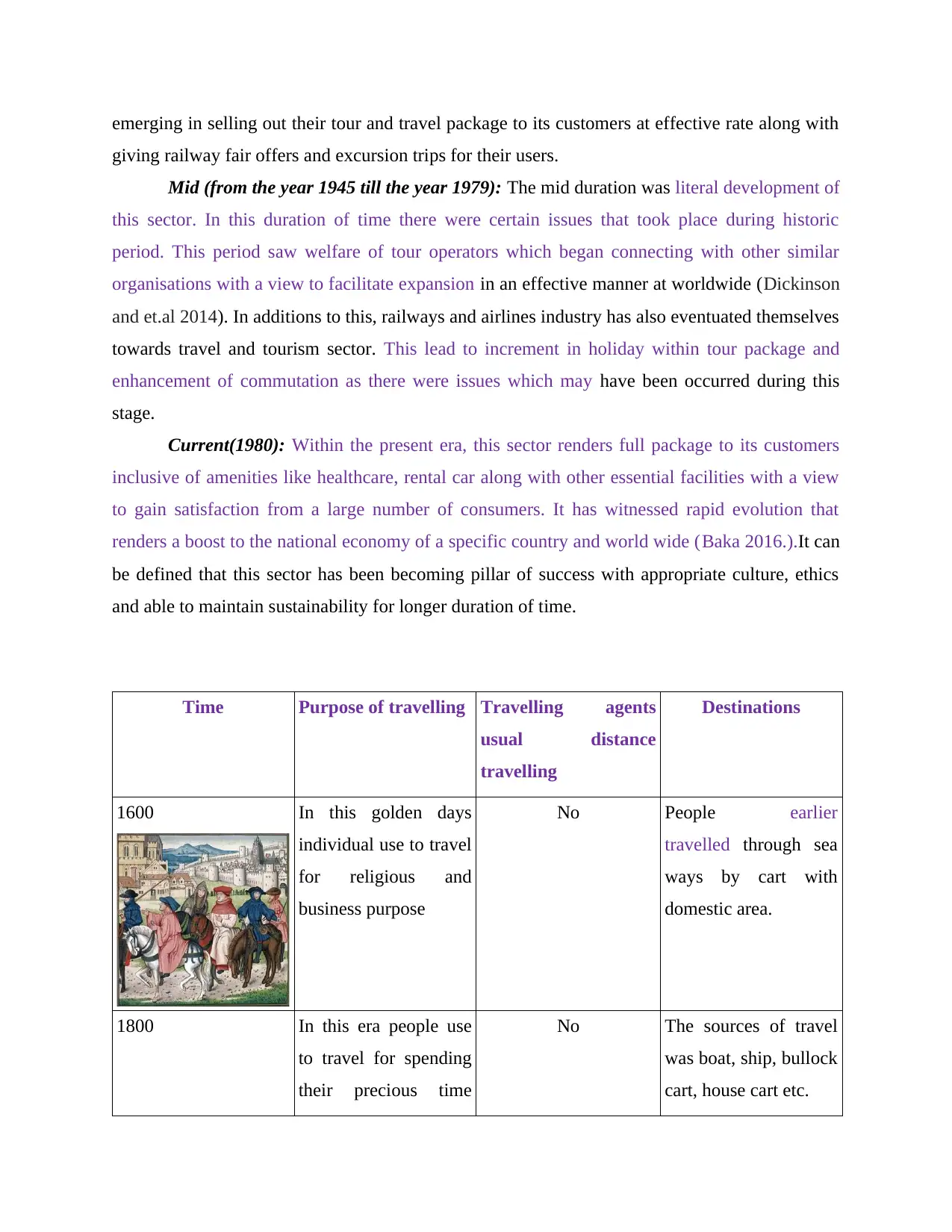
emerging in selling out their tour and travel package to its customers at effective rate along with
giving railway fair offers and excursion trips for their users.
Mid (from the year 1945 till the year 1979): The mid duration was literal development of
this sector. In this duration of time there were certain issues that took place during historic
period. This period saw welfare of tour operators which began connecting with other similar
organisations with a view to facilitate expansion in an effective manner at worldwide (Dickinson
and et.al 2014). In additions to this, railways and airlines industry has also eventuated themselves
towards travel and tourism sector. This lead to increment in holiday within tour package and
enhancement of commutation as there were issues which may have been occurred during this
stage.
Current(1980): Within the present era, this sector renders full package to its customers
inclusive of amenities like healthcare, rental car along with other essential facilities with a view
to gain satisfaction from a large number of consumers. It has witnessed rapid evolution that
renders a boost to the national economy of a specific country and world wide (Baka 2016.).It can
be defined that this sector has been becoming pillar of success with appropriate culture, ethics
and able to maintain sustainability for longer duration of time.
Time Purpose of travelling Travelling agents
usual distance
travelling
Destinations
1600 In this golden days
individual use to travel
for religious and
business purpose
No People earlier
travelled through sea
ways by cart with
domestic area.
1800 In this era people use
to travel for spending
their precious time
No The sources of travel
was boat, ship, bullock
cart, house cart etc.
giving railway fair offers and excursion trips for their users.
Mid (from the year 1945 till the year 1979): The mid duration was literal development of
this sector. In this duration of time there were certain issues that took place during historic
period. This period saw welfare of tour operators which began connecting with other similar
organisations with a view to facilitate expansion in an effective manner at worldwide (Dickinson
and et.al 2014). In additions to this, railways and airlines industry has also eventuated themselves
towards travel and tourism sector. This lead to increment in holiday within tour package and
enhancement of commutation as there were issues which may have been occurred during this
stage.
Current(1980): Within the present era, this sector renders full package to its customers
inclusive of amenities like healthcare, rental car along with other essential facilities with a view
to gain satisfaction from a large number of consumers. It has witnessed rapid evolution that
renders a boost to the national economy of a specific country and world wide (Baka 2016.).It can
be defined that this sector has been becoming pillar of success with appropriate culture, ethics
and able to maintain sustainability for longer duration of time.
Time Purpose of travelling Travelling agents
usual distance
travelling
Destinations
1600 In this golden days
individual use to travel
for religious and
business purpose
No People earlier
travelled through sea
ways by cart with
domestic area.
1800 In this era people use
to travel for spending
their precious time
No The sources of travel
was boat, ship, bullock
cart, house cart etc.
Paraphrase This Document
Need a fresh take? Get an instant paraphrase of this document with our AI Paraphraser
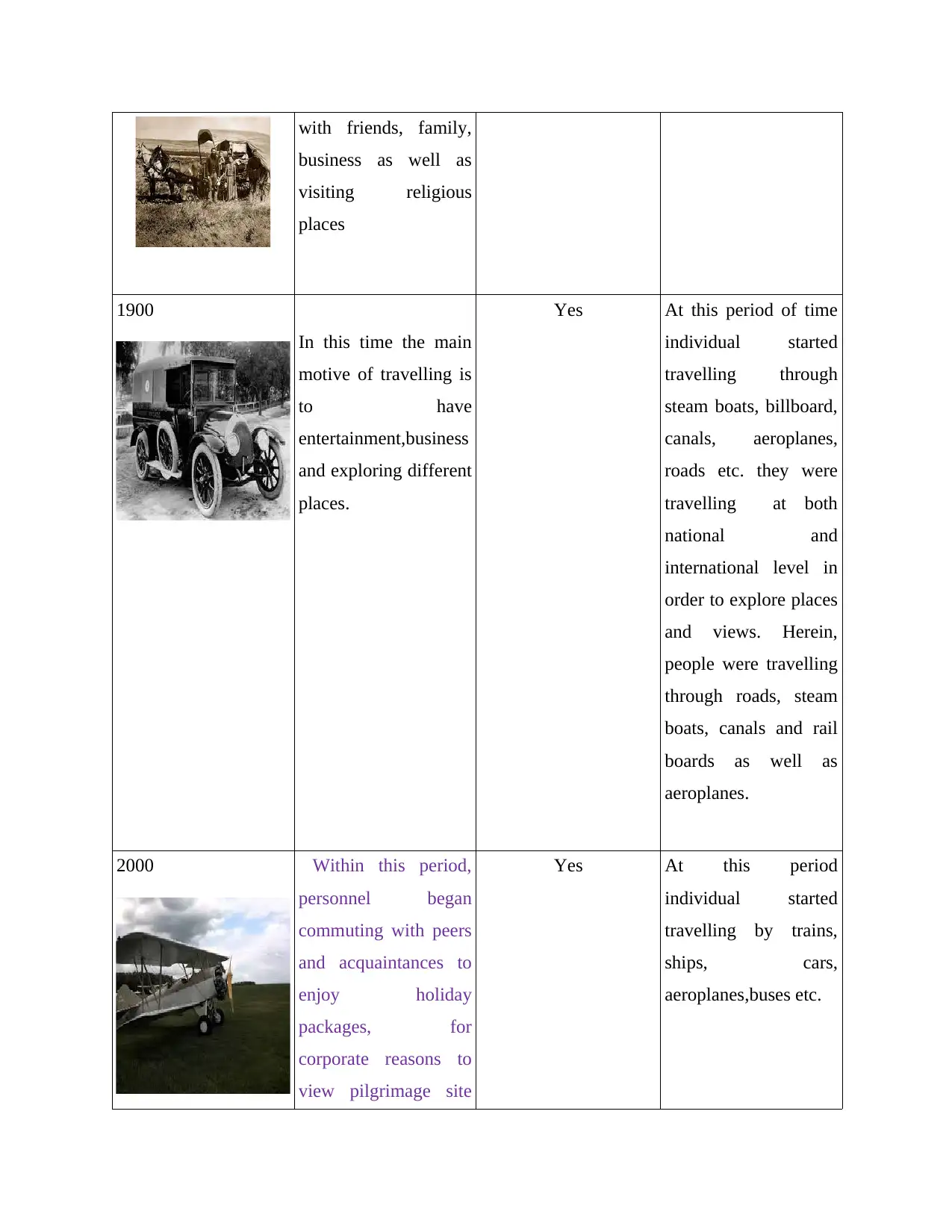
with friends, family,
business as well as
visiting religious
places
1900
In this time the main
motive of travelling is
to have
entertainment,business
and exploring different
places.
Yes At this period of time
individual started
travelling through
steam boats, billboard,
canals, aeroplanes,
roads etc. they were
travelling at both
national and
international level in
order to explore places
and views. Herein,
people were travelling
through roads, steam
boats, canals and rail
boards as well as
aeroplanes.
2000 Within this period,
personnel began
commuting with peers
and acquaintances to
enjoy holiday
packages, for
corporate reasons to
view pilgrimage site
Yes At this period
individual started
travelling by trains,
ships, cars,
aeroplanes,buses etc.
business as well as
visiting religious
places
1900
In this time the main
motive of travelling is
to have
entertainment,business
and exploring different
places.
Yes At this period of time
individual started
travelling through
steam boats, billboard,
canals, aeroplanes,
roads etc. they were
travelling at both
national and
international level in
order to explore places
and views. Herein,
people were travelling
through roads, steam
boats, canals and rail
boards as well as
aeroplanes.
2000 Within this period,
personnel began
commuting with peers
and acquaintances to
enjoy holiday
packages, for
corporate reasons to
view pilgrimage site
Yes At this period
individual started
travelling by trains,
ships, cars,
aeroplanes,buses etc.
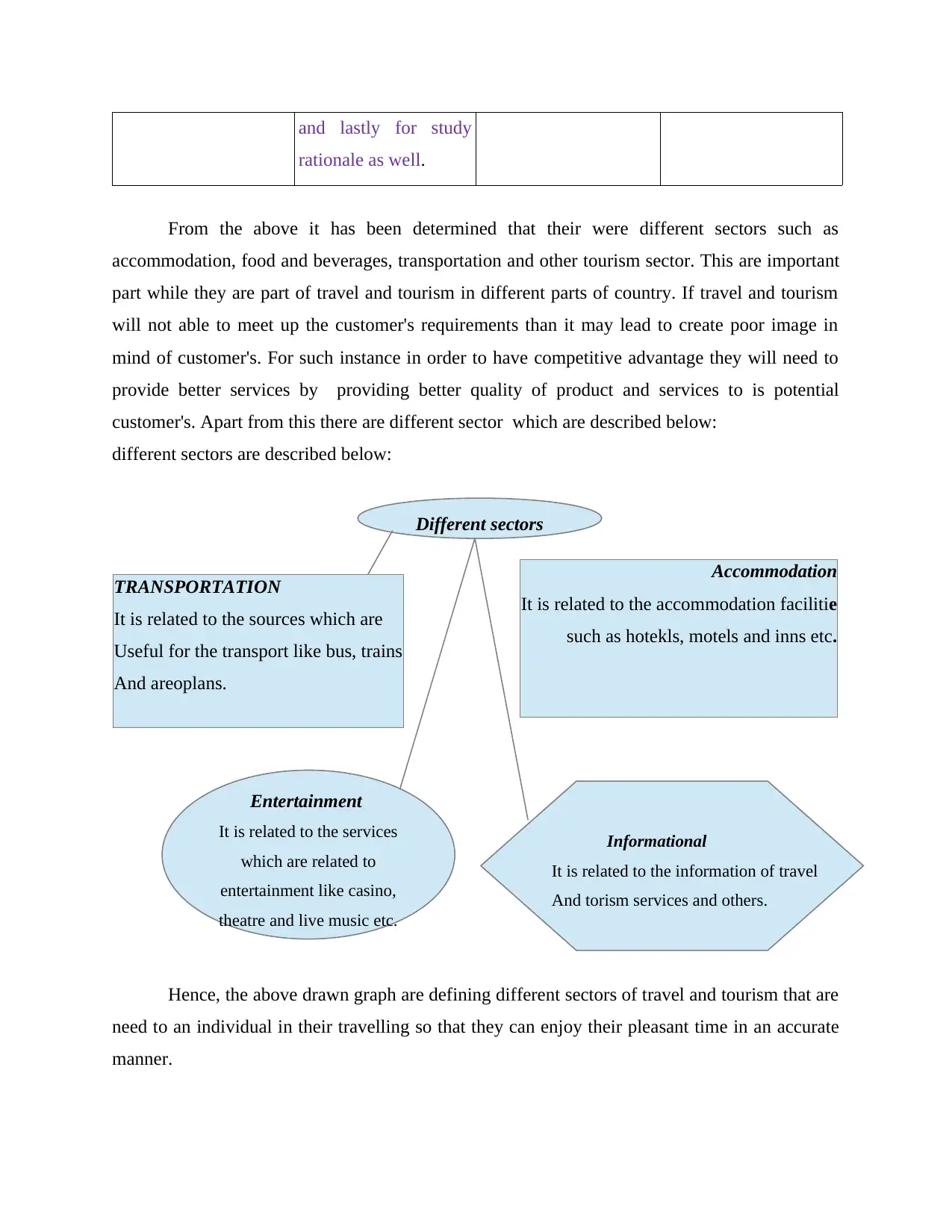
and lastly for study
rationale as well.
From the above it has been determined that their were different sectors such as
accommodation, food and beverages, transportation and other tourism sector. This are important
part while they are part of travel and tourism in different parts of country. If travel and tourism
will not able to meet up the customer's requirements than it may lead to create poor image in
mind of customer's. For such instance in order to have competitive advantage they will need to
provide better services by providing better quality of product and services to is potential
customer's. Apart from this there are different sector which are described below:
different sectors are described below:
Hence, the above drawn graph are defining different sectors of travel and tourism that are
need to an individual in their travelling so that they can enjoy their pleasant time in an accurate
manner.
Different sectors
Accommodation
It is related to the accommodation facilitie
such as hotekls, motels and inns etc.
TRANSPORTATION
It is related to the sources which are
Useful for the transport like bus, trains
And areoplans.
Entertainment
It is related to the services
which are related to
entertainment like casino,
theatre and live music etc.
Informational
It is related to the information of travel
And torism services and others.
rationale as well.
From the above it has been determined that their were different sectors such as
accommodation, food and beverages, transportation and other tourism sector. This are important
part while they are part of travel and tourism in different parts of country. If travel and tourism
will not able to meet up the customer's requirements than it may lead to create poor image in
mind of customer's. For such instance in order to have competitive advantage they will need to
provide better services by providing better quality of product and services to is potential
customer's. Apart from this there are different sector which are described below:
different sectors are described below:
Hence, the above drawn graph are defining different sectors of travel and tourism that are
need to an individual in their travelling so that they can enjoy their pleasant time in an accurate
manner.
Different sectors
Accommodation
It is related to the accommodation facilitie
such as hotekls, motels and inns etc.
TRANSPORTATION
It is related to the sources which are
Useful for the transport like bus, trains
And areoplans.
Entertainment
It is related to the services
which are related to
entertainment like casino,
theatre and live music etc.
Informational
It is related to the information of travel
And torism services and others.
⊘ This is a preview!⊘
Do you want full access?
Subscribe today to unlock all pages.

Trusted by 1+ million students worldwide
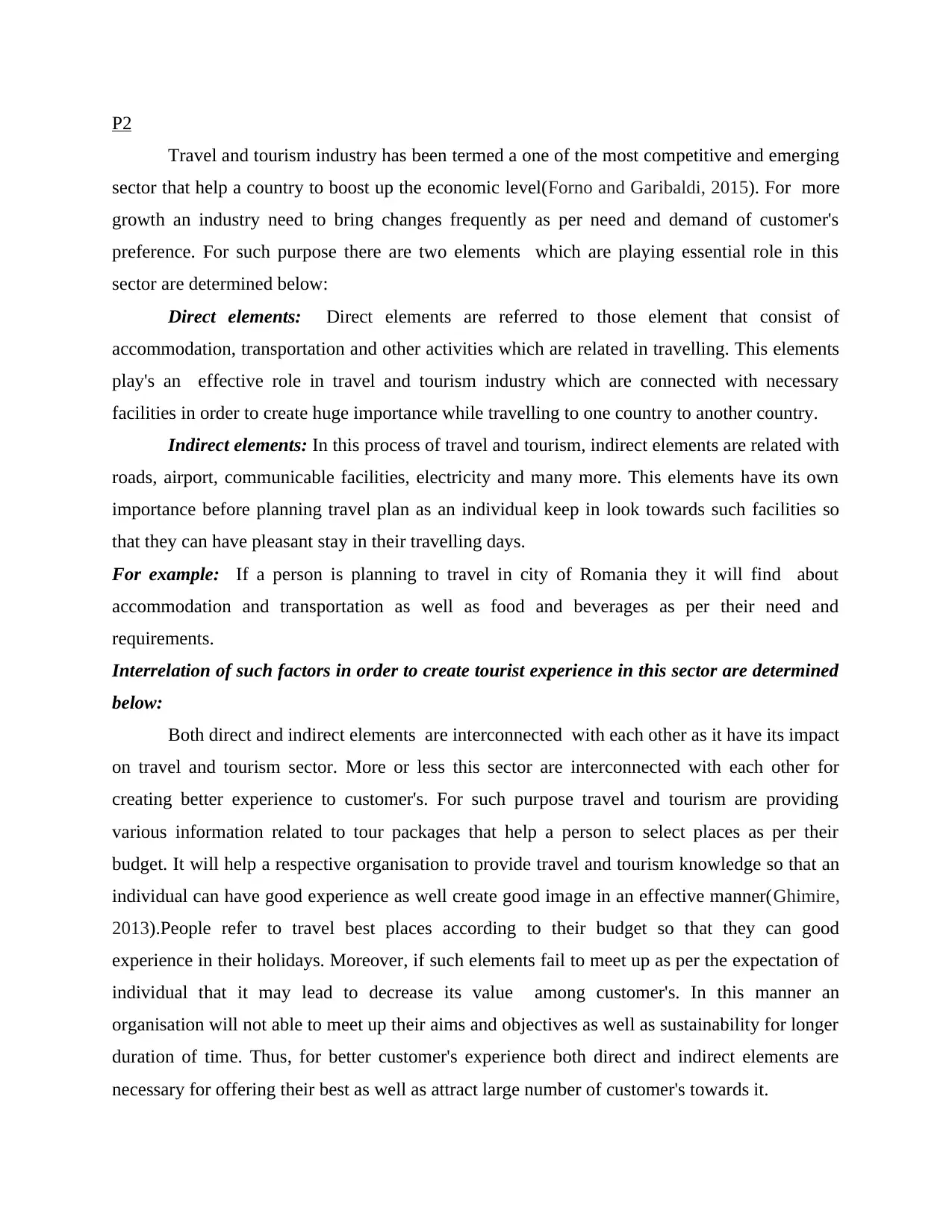
P2
Travel and tourism industry has been termed a one of the most competitive and emerging
sector that help a country to boost up the economic level(Forno and Garibaldi, 2015). For more
growth an industry need to bring changes frequently as per need and demand of customer's
preference. For such purpose there are two elements which are playing essential role in this
sector are determined below:
Direct elements: Direct elements are referred to those element that consist of
accommodation, transportation and other activities which are related in travelling. This elements
play's an effective role in travel and tourism industry which are connected with necessary
facilities in order to create huge importance while travelling to one country to another country.
Indirect elements: In this process of travel and tourism, indirect elements are related with
roads, airport, communicable facilities, electricity and many more. This elements have its own
importance before planning travel plan as an individual keep in look towards such facilities so
that they can have pleasant stay in their travelling days.
For example: If a person is planning to travel in city of Romania they it will find about
accommodation and transportation as well as food and beverages as per their need and
requirements.
Interrelation of such factors in order to create tourist experience in this sector are determined
below:
Both direct and indirect elements are interconnected with each other as it have its impact
on travel and tourism sector. More or less this sector are interconnected with each other for
creating better experience to customer's. For such purpose travel and tourism are providing
various information related to tour packages that help a person to select places as per their
budget. It will help a respective organisation to provide travel and tourism knowledge so that an
individual can have good experience as well create good image in an effective manner(Ghimire,
2013).People refer to travel best places according to their budget so that they can good
experience in their holidays. Moreover, if such elements fail to meet up as per the expectation of
individual that it may lead to decrease its value among customer's. In this manner an
organisation will not able to meet up their aims and objectives as well as sustainability for longer
duration of time. Thus, for better customer's experience both direct and indirect elements are
necessary for offering their best as well as attract large number of customer's towards it.
Travel and tourism industry has been termed a one of the most competitive and emerging
sector that help a country to boost up the economic level(Forno and Garibaldi, 2015). For more
growth an industry need to bring changes frequently as per need and demand of customer's
preference. For such purpose there are two elements which are playing essential role in this
sector are determined below:
Direct elements: Direct elements are referred to those element that consist of
accommodation, transportation and other activities which are related in travelling. This elements
play's an effective role in travel and tourism industry which are connected with necessary
facilities in order to create huge importance while travelling to one country to another country.
Indirect elements: In this process of travel and tourism, indirect elements are related with
roads, airport, communicable facilities, electricity and many more. This elements have its own
importance before planning travel plan as an individual keep in look towards such facilities so
that they can have pleasant stay in their travelling days.
For example: If a person is planning to travel in city of Romania they it will find about
accommodation and transportation as well as food and beverages as per their need and
requirements.
Interrelation of such factors in order to create tourist experience in this sector are determined
below:
Both direct and indirect elements are interconnected with each other as it have its impact
on travel and tourism sector. More or less this sector are interconnected with each other for
creating better experience to customer's. For such purpose travel and tourism are providing
various information related to tour packages that help a person to select places as per their
budget. It will help a respective organisation to provide travel and tourism knowledge so that an
individual can have good experience as well create good image in an effective manner(Ghimire,
2013).People refer to travel best places according to their budget so that they can good
experience in their holidays. Moreover, if such elements fail to meet up as per the expectation of
individual that it may lead to decrease its value among customer's. In this manner an
organisation will not able to meet up their aims and objectives as well as sustainability for longer
duration of time. Thus, for better customer's experience both direct and indirect elements are
necessary for offering their best as well as attract large number of customer's towards it.
Paraphrase This Document
Need a fresh take? Get an instant paraphrase of this document with our AI Paraphraser
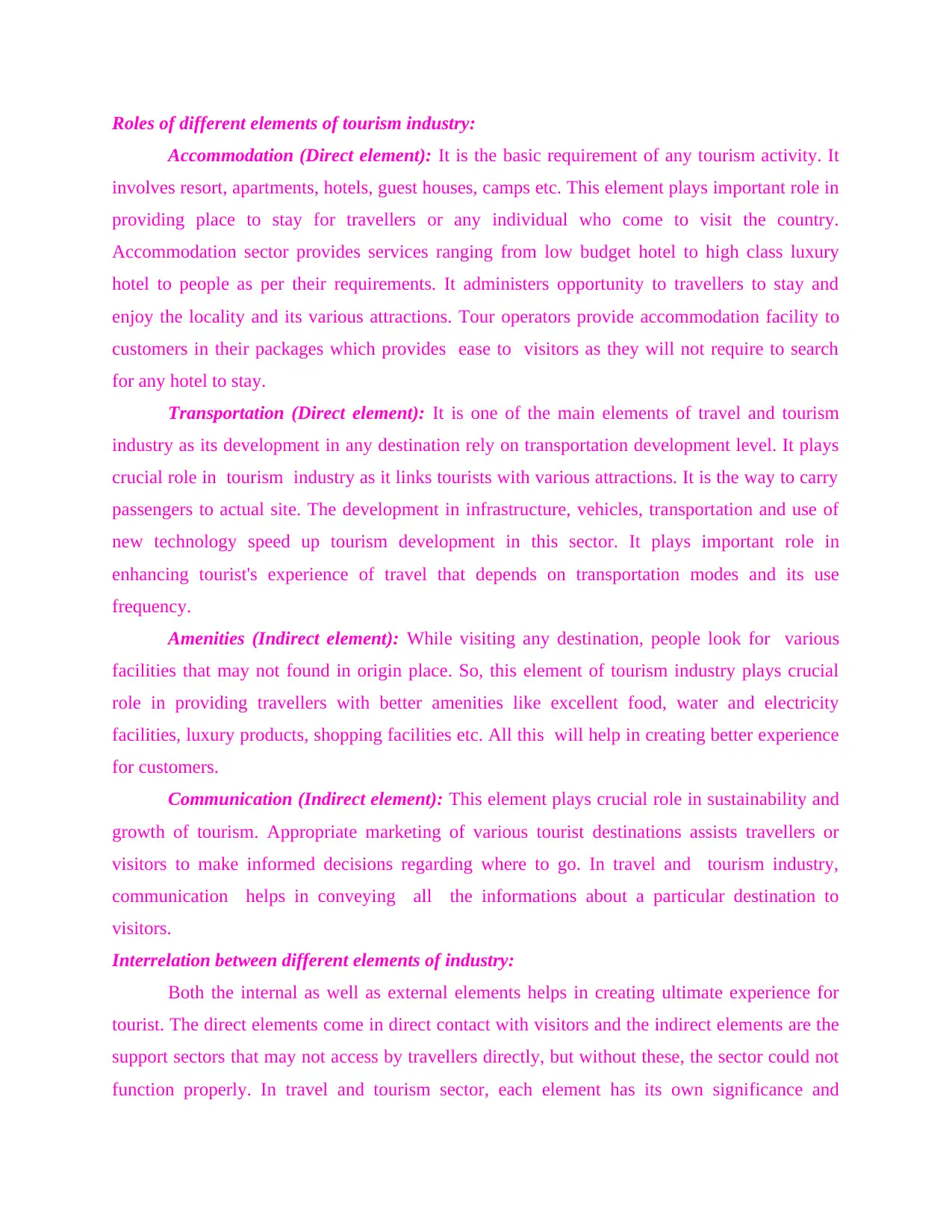
Roles of different elements of tourism industry:
Accommodation (Direct element): It is the basic requirement of any tourism activity. It
involves resort, apartments, hotels, guest houses, camps etc. This element plays important role in
providing place to stay for travellers or any individual who come to visit the country.
Accommodation sector provides services ranging from low budget hotel to high class luxury
hotel to people as per their requirements. It administers opportunity to travellers to stay and
enjoy the locality and its various attractions. Tour operators provide accommodation facility to
customers in their packages which provides ease to visitors as they will not require to search
for any hotel to stay.
Transportation (Direct element): It is one of the main elements of travel and tourism
industry as its development in any destination rely on transportation development level. It plays
crucial role in tourism industry as it links tourists with various attractions. It is the way to carry
passengers to actual site. The development in infrastructure, vehicles, transportation and use of
new technology speed up tourism development in this sector. It plays important role in
enhancing tourist's experience of travel that depends on transportation modes and its use
frequency.
Amenities (Indirect element): While visiting any destination, people look for various
facilities that may not found in origin place. So, this element of tourism industry plays crucial
role in providing travellers with better amenities like excellent food, water and electricity
facilities, luxury products, shopping facilities etc. All this will help in creating better experience
for customers.
Communication (Indirect element): This element plays crucial role in sustainability and
growth of tourism. Appropriate marketing of various tourist destinations assists travellers or
visitors to make informed decisions regarding where to go. In travel and tourism industry,
communication helps in conveying all the informations about a particular destination to
visitors.
Interrelation between different elements of industry:
Both the internal as well as external elements helps in creating ultimate experience for
tourist. The direct elements come in direct contact with visitors and the indirect elements are the
support sectors that may not access by travellers directly, but without these, the sector could not
function properly. In travel and tourism sector, each element has its own significance and
Accommodation (Direct element): It is the basic requirement of any tourism activity. It
involves resort, apartments, hotels, guest houses, camps etc. This element plays important role in
providing place to stay for travellers or any individual who come to visit the country.
Accommodation sector provides services ranging from low budget hotel to high class luxury
hotel to people as per their requirements. It administers opportunity to travellers to stay and
enjoy the locality and its various attractions. Tour operators provide accommodation facility to
customers in their packages which provides ease to visitors as they will not require to search
for any hotel to stay.
Transportation (Direct element): It is one of the main elements of travel and tourism
industry as its development in any destination rely on transportation development level. It plays
crucial role in tourism industry as it links tourists with various attractions. It is the way to carry
passengers to actual site. The development in infrastructure, vehicles, transportation and use of
new technology speed up tourism development in this sector. It plays important role in
enhancing tourist's experience of travel that depends on transportation modes and its use
frequency.
Amenities (Indirect element): While visiting any destination, people look for various
facilities that may not found in origin place. So, this element of tourism industry plays crucial
role in providing travellers with better amenities like excellent food, water and electricity
facilities, luxury products, shopping facilities etc. All this will help in creating better experience
for customers.
Communication (Indirect element): This element plays crucial role in sustainability and
growth of tourism. Appropriate marketing of various tourist destinations assists travellers or
visitors to make informed decisions regarding where to go. In travel and tourism industry,
communication helps in conveying all the informations about a particular destination to
visitors.
Interrelation between different elements of industry:
Both the internal as well as external elements helps in creating ultimate experience for
tourist. The direct elements come in direct contact with visitors and the indirect elements are the
support sectors that may not access by travellers directly, but without these, the sector could not
function properly. In travel and tourism sector, each element has its own significance and
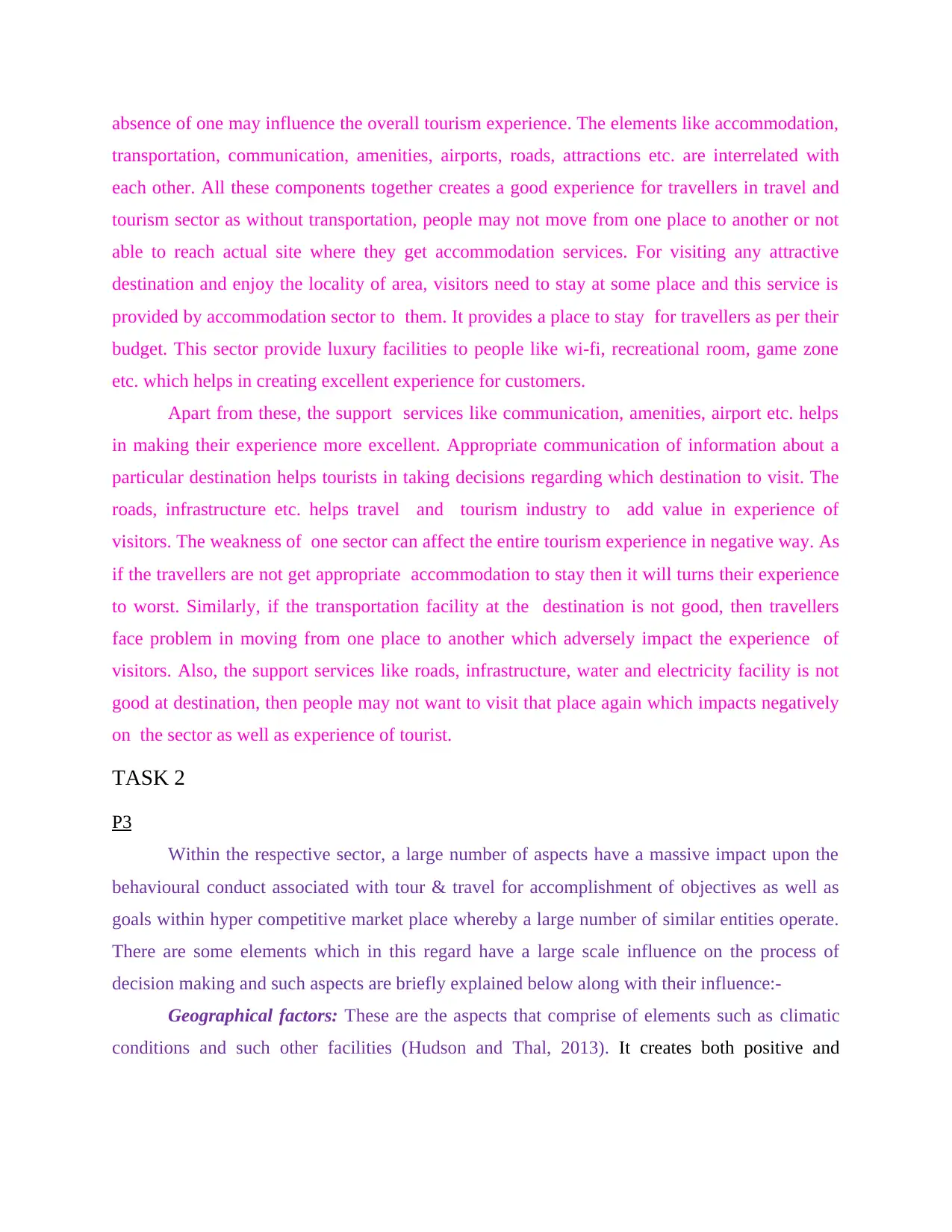
absence of one may influence the overall tourism experience. The elements like accommodation,
transportation, communication, amenities, airports, roads, attractions etc. are interrelated with
each other. All these components together creates a good experience for travellers in travel and
tourism sector as without transportation, people may not move from one place to another or not
able to reach actual site where they get accommodation services. For visiting any attractive
destination and enjoy the locality of area, visitors need to stay at some place and this service is
provided by accommodation sector to them. It provides a place to stay for travellers as per their
budget. This sector provide luxury facilities to people like wi-fi, recreational room, game zone
etc. which helps in creating excellent experience for customers.
Apart from these, the support services like communication, amenities, airport etc. helps
in making their experience more excellent. Appropriate communication of information about a
particular destination helps tourists in taking decisions regarding which destination to visit. The
roads, infrastructure etc. helps travel and tourism industry to add value in experience of
visitors. The weakness of one sector can affect the entire tourism experience in negative way. As
if the travellers are not get appropriate accommodation to stay then it will turns their experience
to worst. Similarly, if the transportation facility at the destination is not good, then travellers
face problem in moving from one place to another which adversely impact the experience of
visitors. Also, the support services like roads, infrastructure, water and electricity facility is not
good at destination, then people may not want to visit that place again which impacts negatively
on the sector as well as experience of tourist.
TASK 2
P3
Within the respective sector, a large number of aspects have a massive impact upon the
behavioural conduct associated with tour & travel for accomplishment of objectives as well as
goals within hyper competitive market place whereby a large number of similar entities operate.
There are some elements which in this regard have a large scale influence on the process of
decision making and such aspects are briefly explained below along with their influence:-
Geographical factors: These are the aspects that comprise of elements such as climatic
conditions and such other facilities (Hudson and Thal, 2013). It creates both positive and
transportation, communication, amenities, airports, roads, attractions etc. are interrelated with
each other. All these components together creates a good experience for travellers in travel and
tourism sector as without transportation, people may not move from one place to another or not
able to reach actual site where they get accommodation services. For visiting any attractive
destination and enjoy the locality of area, visitors need to stay at some place and this service is
provided by accommodation sector to them. It provides a place to stay for travellers as per their
budget. This sector provide luxury facilities to people like wi-fi, recreational room, game zone
etc. which helps in creating excellent experience for customers.
Apart from these, the support services like communication, amenities, airport etc. helps
in making their experience more excellent. Appropriate communication of information about a
particular destination helps tourists in taking decisions regarding which destination to visit. The
roads, infrastructure etc. helps travel and tourism industry to add value in experience of
visitors. The weakness of one sector can affect the entire tourism experience in negative way. As
if the travellers are not get appropriate accommodation to stay then it will turns their experience
to worst. Similarly, if the transportation facility at the destination is not good, then travellers
face problem in moving from one place to another which adversely impact the experience of
visitors. Also, the support services like roads, infrastructure, water and electricity facility is not
good at destination, then people may not want to visit that place again which impacts negatively
on the sector as well as experience of tourist.
TASK 2
P3
Within the respective sector, a large number of aspects have a massive impact upon the
behavioural conduct associated with tour & travel for accomplishment of objectives as well as
goals within hyper competitive market place whereby a large number of similar entities operate.
There are some elements which in this regard have a large scale influence on the process of
decision making and such aspects are briefly explained below along with their influence:-
Geographical factors: These are the aspects that comprise of elements such as climatic
conditions and such other facilities (Hudson and Thal, 2013). It creates both positive and
⊘ This is a preview!⊘
Do you want full access?
Subscribe today to unlock all pages.

Trusted by 1+ million students worldwide
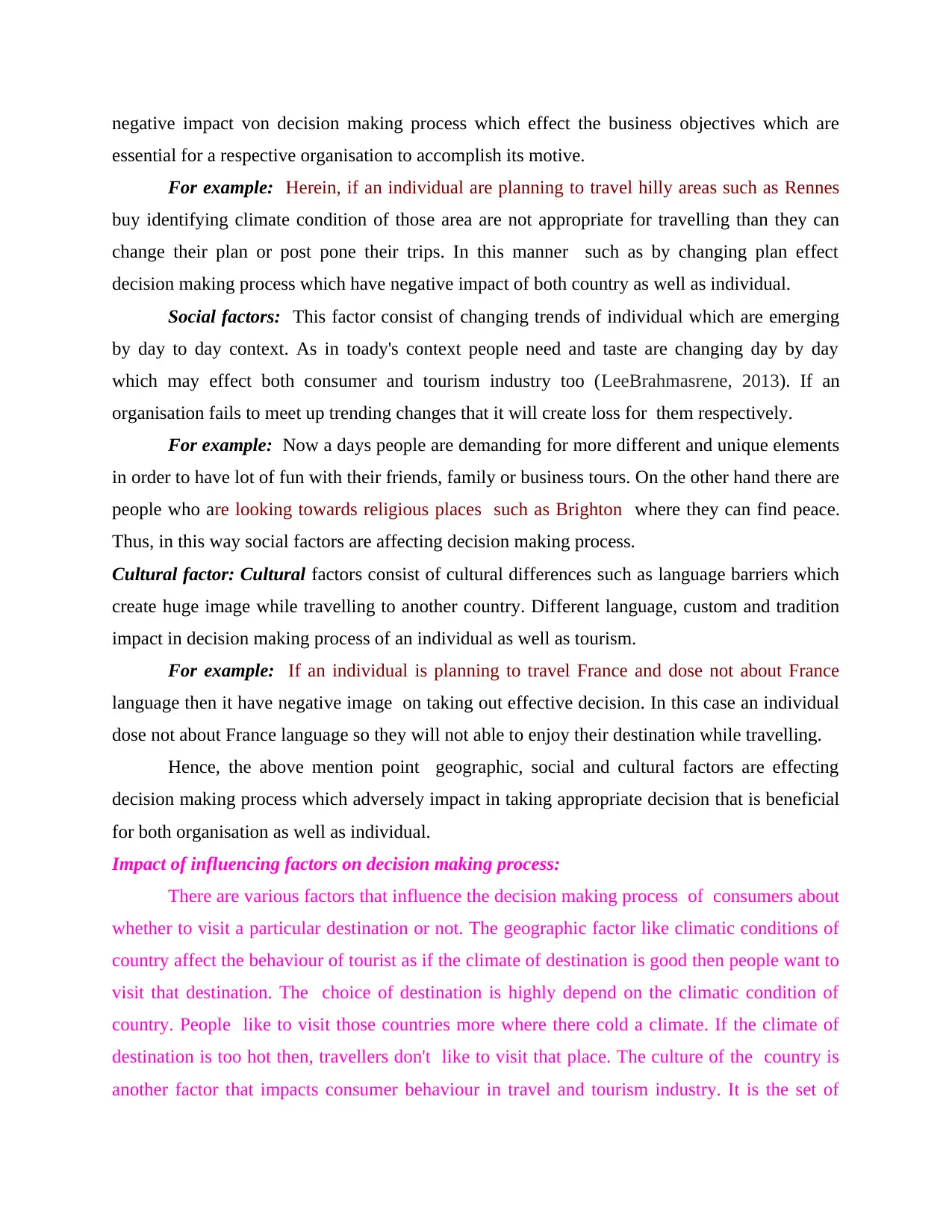
negative impact von decision making process which effect the business objectives which are
essential for a respective organisation to accomplish its motive.
For example: Herein, if an individual are planning to travel hilly areas such as Rennes
buy identifying climate condition of those area are not appropriate for travelling than they can
change their plan or post pone their trips. In this manner such as by changing plan effect
decision making process which have negative impact of both country as well as individual.
Social factors: This factor consist of changing trends of individual which are emerging
by day to day context. As in toady's context people need and taste are changing day by day
which may effect both consumer and tourism industry too (LeeBrahmasrene, 2013). If an
organisation fails to meet up trending changes that it will create loss for them respectively.
For example: Now a days people are demanding for more different and unique elements
in order to have lot of fun with their friends, family or business tours. On the other hand there are
people who are looking towards religious places such as Brighton where they can find peace.
Thus, in this way social factors are affecting decision making process.
Cultural factor: Cultural factors consist of cultural differences such as language barriers which
create huge image while travelling to another country. Different language, custom and tradition
impact in decision making process of an individual as well as tourism.
For example: If an individual is planning to travel France and dose not about France
language then it have negative image on taking out effective decision. In this case an individual
dose not about France language so they will not able to enjoy their destination while travelling.
Hence, the above mention point geographic, social and cultural factors are effecting
decision making process which adversely impact in taking appropriate decision that is beneficial
for both organisation as well as individual.
Impact of influencing factors on decision making process:
There are various factors that influence the decision making process of consumers about
whether to visit a particular destination or not. The geographic factor like climatic conditions of
country affect the behaviour of tourist as if the climate of destination is good then people want to
visit that destination. The choice of destination is highly depend on the climatic condition of
country. People like to visit those countries more where there cold a climate. If the climate of
destination is too hot then, travellers don't like to visit that place. The culture of the country is
another factor that impacts consumer behaviour in travel and tourism industry. It is the set of
essential for a respective organisation to accomplish its motive.
For example: Herein, if an individual are planning to travel hilly areas such as Rennes
buy identifying climate condition of those area are not appropriate for travelling than they can
change their plan or post pone their trips. In this manner such as by changing plan effect
decision making process which have negative impact of both country as well as individual.
Social factors: This factor consist of changing trends of individual which are emerging
by day to day context. As in toady's context people need and taste are changing day by day
which may effect both consumer and tourism industry too (LeeBrahmasrene, 2013). If an
organisation fails to meet up trending changes that it will create loss for them respectively.
For example: Now a days people are demanding for more different and unique elements
in order to have lot of fun with their friends, family or business tours. On the other hand there are
people who are looking towards religious places such as Brighton where they can find peace.
Thus, in this way social factors are affecting decision making process.
Cultural factor: Cultural factors consist of cultural differences such as language barriers which
create huge image while travelling to another country. Different language, custom and tradition
impact in decision making process of an individual as well as tourism.
For example: If an individual is planning to travel France and dose not about France
language then it have negative image on taking out effective decision. In this case an individual
dose not about France language so they will not able to enjoy their destination while travelling.
Hence, the above mention point geographic, social and cultural factors are effecting
decision making process which adversely impact in taking appropriate decision that is beneficial
for both organisation as well as individual.
Impact of influencing factors on decision making process:
There are various factors that influence the decision making process of consumers about
whether to visit a particular destination or not. The geographic factor like climatic conditions of
country affect the behaviour of tourist as if the climate of destination is good then people want to
visit that destination. The choice of destination is highly depend on the climatic condition of
country. People like to visit those countries more where there cold a climate. If the climate of
destination is too hot then, travellers don't like to visit that place. The culture of the country is
another factor that impacts consumer behaviour in travel and tourism industry. It is the set of
Paraphrase This Document
Need a fresh take? Get an instant paraphrase of this document with our AI Paraphraser
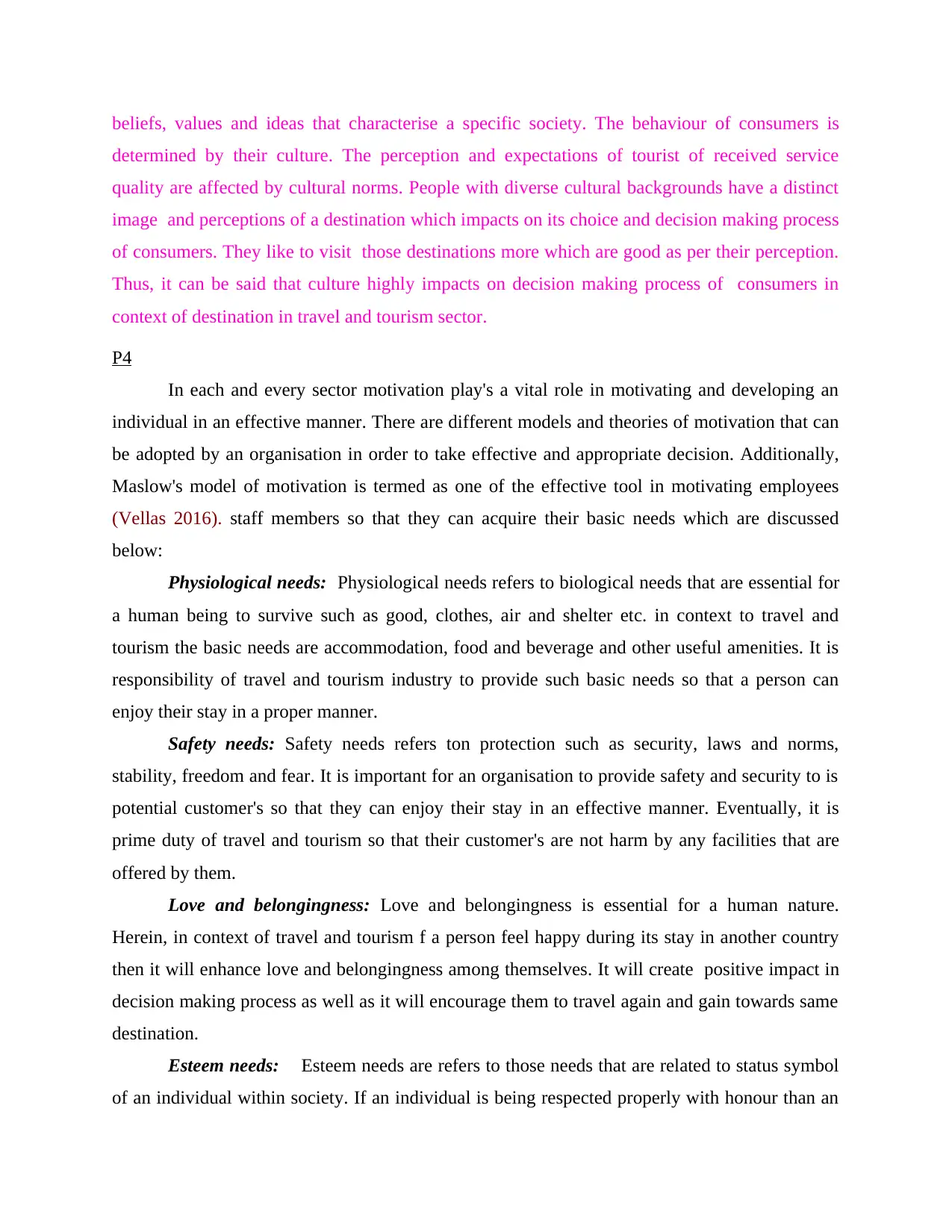
beliefs, values and ideas that characterise a specific society. The behaviour of consumers is
determined by their culture. The perception and expectations of tourist of received service
quality are affected by cultural norms. People with diverse cultural backgrounds have a distinct
image and perceptions of a destination which impacts on its choice and decision making process
of consumers. They like to visit those destinations more which are good as per their perception.
Thus, it can be said that culture highly impacts on decision making process of consumers in
context of destination in travel and tourism sector.
P4
In each and every sector motivation play's a vital role in motivating and developing an
individual in an effective manner. There are different models and theories of motivation that can
be adopted by an organisation in order to take effective and appropriate decision. Additionally,
Maslow's model of motivation is termed as one of the effective tool in motivating employees
(Vellas 2016). staff members so that they can acquire their basic needs which are discussed
below:
Physiological needs: Physiological needs refers to biological needs that are essential for
a human being to survive such as good, clothes, air and shelter etc. in context to travel and
tourism the basic needs are accommodation, food and beverage and other useful amenities. It is
responsibility of travel and tourism industry to provide such basic needs so that a person can
enjoy their stay in a proper manner.
Safety needs: Safety needs refers ton protection such as security, laws and norms,
stability, freedom and fear. It is important for an organisation to provide safety and security to is
potential customer's so that they can enjoy their stay in an effective manner. Eventually, it is
prime duty of travel and tourism so that their customer's are not harm by any facilities that are
offered by them.
Love and belongingness: Love and belongingness is essential for a human nature.
Herein, in context of travel and tourism f a person feel happy during its stay in another country
then it will enhance love and belongingness among themselves. It will create positive impact in
decision making process as well as it will encourage them to travel again and gain towards same
destination.
Esteem needs: Esteem needs are refers to those needs that are related to status symbol
of an individual within society. If an individual is being respected properly with honour than an
determined by their culture. The perception and expectations of tourist of received service
quality are affected by cultural norms. People with diverse cultural backgrounds have a distinct
image and perceptions of a destination which impacts on its choice and decision making process
of consumers. They like to visit those destinations more which are good as per their perception.
Thus, it can be said that culture highly impacts on decision making process of consumers in
context of destination in travel and tourism sector.
P4
In each and every sector motivation play's a vital role in motivating and developing an
individual in an effective manner. There are different models and theories of motivation that can
be adopted by an organisation in order to take effective and appropriate decision. Additionally,
Maslow's model of motivation is termed as one of the effective tool in motivating employees
(Vellas 2016). staff members so that they can acquire their basic needs which are discussed
below:
Physiological needs: Physiological needs refers to biological needs that are essential for
a human being to survive such as good, clothes, air and shelter etc. in context to travel and
tourism the basic needs are accommodation, food and beverage and other useful amenities. It is
responsibility of travel and tourism industry to provide such basic needs so that a person can
enjoy their stay in a proper manner.
Safety needs: Safety needs refers ton protection such as security, laws and norms,
stability, freedom and fear. It is important for an organisation to provide safety and security to is
potential customer's so that they can enjoy their stay in an effective manner. Eventually, it is
prime duty of travel and tourism so that their customer's are not harm by any facilities that are
offered by them.
Love and belongingness: Love and belongingness is essential for a human nature.
Herein, in context of travel and tourism f a person feel happy during its stay in another country
then it will enhance love and belongingness among themselves. It will create positive impact in
decision making process as well as it will encourage them to travel again and gain towards same
destination.
Esteem needs: Esteem needs are refers to those needs that are related to status symbol
of an individual within society. If an individual is being respected properly with honour than an
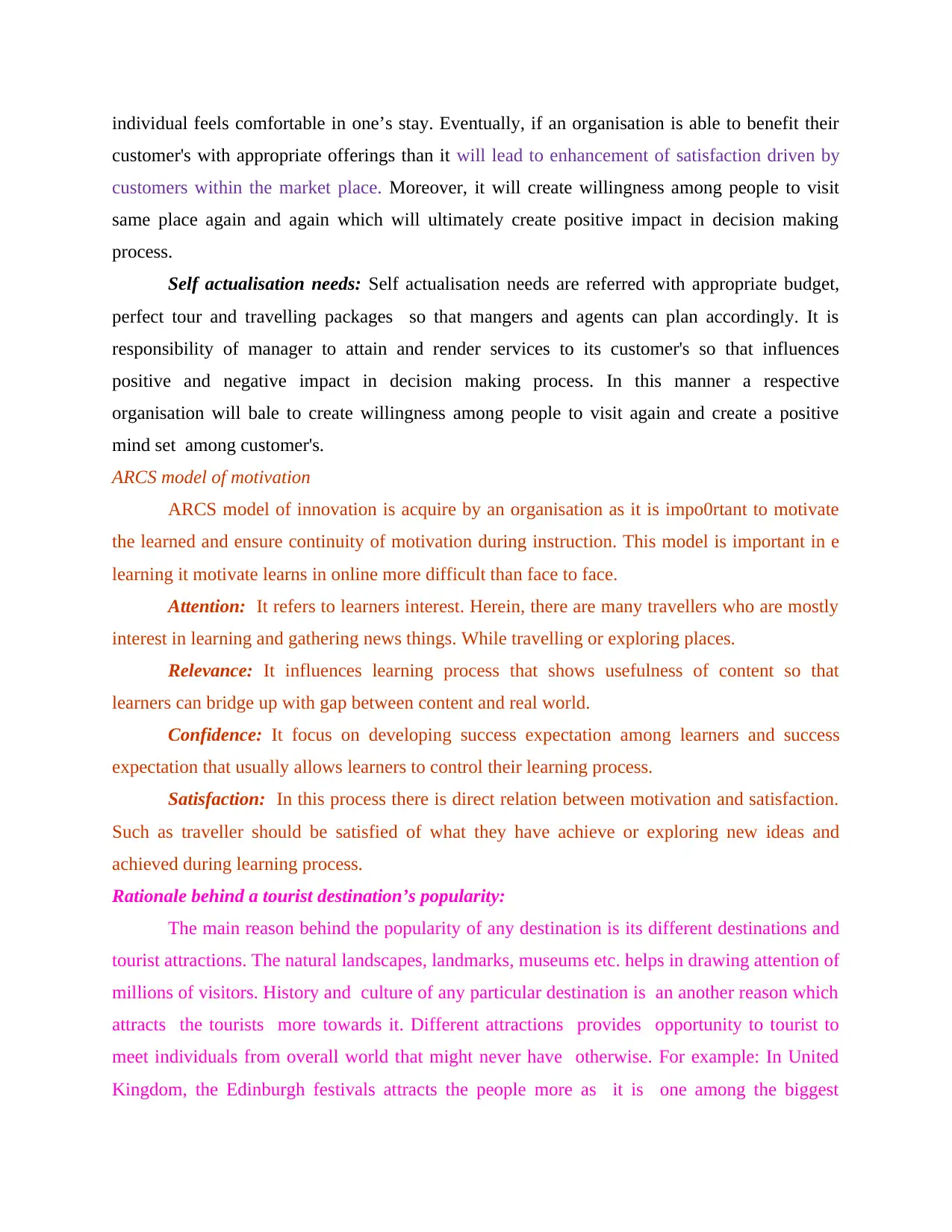
individual feels comfortable in one’s stay. Eventually, if an organisation is able to benefit their
customer's with appropriate offerings than it will lead to enhancement of satisfaction driven by
customers within the market place. Moreover, it will create willingness among people to visit
same place again and again which will ultimately create positive impact in decision making
process.
Self actualisation needs: Self actualisation needs are referred with appropriate budget,
perfect tour and travelling packages so that mangers and agents can plan accordingly. It is
responsibility of manager to attain and render services to its customer's so that influences
positive and negative impact in decision making process. In this manner a respective
organisation will bale to create willingness among people to visit again and create a positive
mind set among customer's.
ARCS model of motivation
ARCS model of innovation is acquire by an organisation as it is impo0rtant to motivate
the learned and ensure continuity of motivation during instruction. This model is important in e
learning it motivate learns in online more difficult than face to face.
Attention: It refers to learners interest. Herein, there are many travellers who are mostly
interest in learning and gathering news things. While travelling or exploring places.
Relevance: It influences learning process that shows usefulness of content so that
learners can bridge up with gap between content and real world.
Confidence: It focus on developing success expectation among learners and success
expectation that usually allows learners to control their learning process.
Satisfaction: In this process there is direct relation between motivation and satisfaction.
Such as traveller should be satisfied of what they have achieve or exploring new ideas and
achieved during learning process.
Rationale behind a tourist destination’s popularity:
The main reason behind the popularity of any destination is its different destinations and
tourist attractions. The natural landscapes, landmarks, museums etc. helps in drawing attention of
millions of visitors. History and culture of any particular destination is an another reason which
attracts the tourists more towards it. Different attractions provides opportunity to tourist to
meet individuals from overall world that might never have otherwise. For example: In United
Kingdom, the Edinburgh festivals attracts the people more as it is one among the biggest
customer's with appropriate offerings than it will lead to enhancement of satisfaction driven by
customers within the market place. Moreover, it will create willingness among people to visit
same place again and again which will ultimately create positive impact in decision making
process.
Self actualisation needs: Self actualisation needs are referred with appropriate budget,
perfect tour and travelling packages so that mangers and agents can plan accordingly. It is
responsibility of manager to attain and render services to its customer's so that influences
positive and negative impact in decision making process. In this manner a respective
organisation will bale to create willingness among people to visit again and create a positive
mind set among customer's.
ARCS model of motivation
ARCS model of innovation is acquire by an organisation as it is impo0rtant to motivate
the learned and ensure continuity of motivation during instruction. This model is important in e
learning it motivate learns in online more difficult than face to face.
Attention: It refers to learners interest. Herein, there are many travellers who are mostly
interest in learning and gathering news things. While travelling or exploring places.
Relevance: It influences learning process that shows usefulness of content so that
learners can bridge up with gap between content and real world.
Confidence: It focus on developing success expectation among learners and success
expectation that usually allows learners to control their learning process.
Satisfaction: In this process there is direct relation between motivation and satisfaction.
Such as traveller should be satisfied of what they have achieve or exploring new ideas and
achieved during learning process.
Rationale behind a tourist destination’s popularity:
The main reason behind the popularity of any destination is its different destinations and
tourist attractions. The natural landscapes, landmarks, museums etc. helps in drawing attention of
millions of visitors. History and culture of any particular destination is an another reason which
attracts the tourists more towards it. Different attractions provides opportunity to tourist to
meet individuals from overall world that might never have otherwise. For example: In United
Kingdom, the Edinburgh festivals attracts the people more as it is one among the biggest
⊘ This is a preview!⊘
Do you want full access?
Subscribe today to unlock all pages.

Trusted by 1+ million students worldwide
1 out of 18
Related Documents
Your All-in-One AI-Powered Toolkit for Academic Success.
+13062052269
info@desklib.com
Available 24*7 on WhatsApp / Email
![[object Object]](/_next/static/media/star-bottom.7253800d.svg)
Unlock your academic potential
Copyright © 2020–2025 A2Z Services. All Rights Reserved. Developed and managed by ZUCOL.





